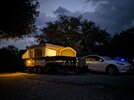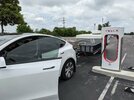Took the Tesla and RTTC Grizzly out for a shakedown tow. The weather was not great, cold (38F), rain and windy in comparison to my not towing baselines, but here are my takeaways:
The Tesla hitch design sucks. Whoever thought any of this was a good design has obviously never towed anything and should be fired! I have to kneel on the ground behind the car to see what I'm doing!!
As has been widely reported the hitch cover is impossible to remove without tools and causing some damage to it. Clips have been removed, but still not good.
The safety chain hooks are buried and not visible, then the chains, once actually hooked up, contact the rear bumper potentially causing scuffing (I wrapped them to prevent this, but come on Tesla!)
The trailer 7-pin connector is also buried and causes issues if you try to connect a 4-pin to 7-pin adapter as the opening is small, and you can't open the cover flap wide to cleat the retention latch.
Anti rattle brackets will not fit on the hitch
Set Up
Tow vehicle - Model Y AWD LR
Camper - Rustic Trail Teardrop Campers Grizzly ~ 1700lbs as towed -
Grizzly Bear | Rustic Trail Teardrop Campers
Test route out and back totaling 50 miles with 28 miles of highway @~65-70mph + 22 miles of backroads @~25-30mph. Minimal elevation change.
Non towing consumption
Northbound = 280wh/mile
Southbound = 246wh/mile
Towing consumption
Northbound = 540wh/mile
Southbound = 460wh/mile
Summary
The car tows effortlessly, installing and removing the tow ball and connecting the electrics and chains is horrible. Consumption increase is basically doubled, but not unmanageable and will meet our needs for our typical trips, but probably not great for super long cross country road trips, I'd probably revert to a tent and B&B's for long trips.
It will be interesting to see the performance over the summer when the weather is warmer, but overall it is a usable solution for towing our small camper
View attachment 654577





